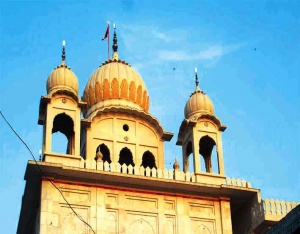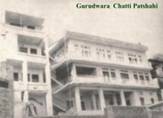Gurdwara Chatti Padshahi Rajouri
Gurdwara Chatti Padshahi Rajouri
Rajouri is a district of composite cultural heritage. The people of various castes and creed are living in the district in a cordial atmosphere. The Sikh population in the district is about 15000. This tiny minority comprises only 2.42% of the total population of the district. However, the Sikh community of Rajouri have maintained their distinct identity and cultural heritage. Number of Gurudwaras is existing in the district, but Gurudwara Chatti Padshahi Rajouri is a very important religious place which has been constructed in the memory of 6th Guru Hargobind Sahib ji (1595-1646) who stayed at this place in 1616 AD when he was on the way to Kashmir along with the Caravan of Emperor Jahangir.
As per the legend, once Guru Hargobind Sahib Ji Maharaj had a dream that Mai Bhagwanti (popularly known as Mai Bhagpari) in Kashmir had prepared a cholla (long shirt) for Guru Ji and she was praying to God for the glimpses of Guru Ji so that she could present it to him, as she was too old and not in a position to visit Punjab and fulfill her aspirations. Therefore, Guru Ji decided to visit Kashmir and take present from the devotee Mai Bhagwanti and to preach Sikhism in the mountainous belt of Peer Panchal and Kashmir.
As per the inscription in Gurudwara Sahib Nowshera, Guru Hargobind Sahib Ji entered Rajouri district in the year 1616 AD. Firstly, Guru Ji reached Jhangar and stayed in a house of a Brahman namely Jhangir Dass. (Later on, the name of the area also became Jhangar). At Jhangar, Guru Ji also met Bawa Beeram Shah Ji Dutt and after detail deliberations with Bawa Beeram Shah Ji regarding the religious matter, Guru Ji selected him for preaching of Sikhism in the foothills of Panchal range starting from Poonch to Dharmasal in Kalakote and posted him at Jhangar.
Guru Ji then came to Nowshera along with the Mughal Emperor Jhangir. Emperor Jhangir was putting up in Nowshera fort while Guru Ji preferred to stay with the people living opposite Nowshera fort. Presently, a well-designed Gurudwara is being constructed at that place in the memory of the visit of Guru Ji.
After relaxing at Nowshera, the Mughal Caravan left for Rajouri via Chingus Sarai. At Rajouri, Emperor Jahangir camped at Baradari opposite Rajouri town on the bank of Salaini Nallah which was constructed by a great Irani Engineer Ali Mardan Khan on the orders of Mughal Emperor. However, Guru Hargobind Ji stayed in house of a Sehajdari Sikhim the town opposite the Sarai which was constructed by the Jaral Rajas of Rajouri (Presently, this Sarai is being used as police post). When the people of Rajouri came to know about the presence of Guru Ji in the town, they started gathering around him. It is said that the gathering in the Darbar of Guru Ji was bigger than the gatherings in the court of Emperor Jahangir at Rajouri. This was brought into the notice of Emperor Jahangir that people instead of visiting his Darbar preferred to visit the Darbar of Guru Hargobind Ji. Emperor Jahangir sent a message to Guru Ji and requested for staying with him. But Guru Ji replied that he wants to stay with the people for spreading the teachings of Sikhism. Therefore Guru Ji stayed here for few days and remain preaching the spiritual thoughts of Guru Nanak Dev Ji Maharaj.
After passing few days at Rajouri, Guru Ji left for Srinagar along with the Mughal Emperor via Thannamandi, Behramgalla, Aliabad, Shopian etc. A Gurudwara was also constructed at Thannamandi in the memory of Guru Ji's visit. But now this religious place is in deplorable condition as no body is there to look after the Gurudwara Sahib.
Since the 6th Guru stayed at Rajouri for few days and preached Sikhism to the public during his stay, therefore a good number of people became their devotee and disciple. They constructed a small Gurudwara (at that time, it was known as Dharamsal) in memory of Guru Ji's stay in the Rajouri town. With the passage of time, Rajouri witnessed number of political developments, but no body disturbed this Gurudwara.
During 1931-32 AD, Rajouri tehsil was a part of Reasi district and the Wazir-e-Wazarat of the district was Sardar Tirath Singh, who used to visit Rajouri for administrative purposes. When people told him about the importance of Gurudwara Sahib Chatti Padshahi Rajouri, it is said that Sardar Tirath Singh collected funds from the public and started Karsewa for the construction of Gurudwara Sahib. He himself lifted stones from Salani Nallah for the construction of this Gurudwara. Therefore, a Pacca Gurudwara building was constructed during 1931-32 AD. However, the building was not so big and the capacity in the Dewan Hall was only for 60-70 persons. It was a double storey building and in those days, double storey buildings were known as Bangala, therefore, this Gurudwara was know as 'Gurudwara Chatti Padshahi Bangla Sahib Rajouri'. During the happenings of 1947 when more than 70% buildings of Rajouri town were destroyed by the raiders the Gurudwara building remained intact.
In 1960, a memorandum was passed by the Sangat for re-construction of Gurudwara Chatti Padhshahi Rajouri and the committee was asked to work for the construction and collection of funds. For this purpose, the prominent persons of Rajouri town were included in the Committee and a separate construction Sub-Committee was constituted.
In 1964, the blue print of new Gurudwara was prepared by an Engineer Sardar Tara Singh of Punjab who was working in MES as SDO and was posted at Rajouri at that time. After the approval of blue print by the Sangat, the construction was started in 1964. The masons and carpenters were brought from Punjab for giving Sikh architectural touch. By this way, the first phase of the building was completed. The four storey Gurudwara has accommodation of 15 rooms for Yatries apart from a big Dewan Hall.
No doubt that there are only 21 Sikh families residing in the town and some Sikh families are inhabitating in the villages like Saranoo, Bathuni, Mera, Sawni, Gurdhanbala, Sadhyal, Dehrian-Tralla, Chityari etc but the Gurudwara Chatti Padshahi have great importance for Hindus also. Number of Hindu devotees visit this Gurudwara for offering prayers. The main congregation is organized on Sunday. The Birthday of Guru Hargobind Ji Maharaj is celebrated with great enthusiasm jointly by Sikhs and Hindus every year. Therefore Gurudwara Chatti Padshahi Rajouri is considered the symbol of communal harmony in the area apart from its religious importance.


